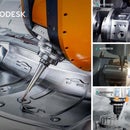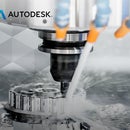Introduction: 3D Machining
This lesson will explore the world of 3D machining so that you may machine your detailed reliefs in ArtCAM Premium.
Note: All files can be found at the bottom of each lesson. Feel free to save the files to your own directory.
Step 1: Example 7-1
Step 2: Lizard Machining Tutorial
For this project we will machine the finished lizard into a soft material such as HDU. The lizard will then be cut out of the material. We will start by using a Machine Relief toolpath within a selected vector area so as to avoid machining the flat background which in this case we do not need. The lizard will be then cut out of the material using a Profile toolpath. We would like the finished lizard to have total height of 1.5”, but the lizard relief is currently 1.545”, so the lizard must first be scaled down in the Z prior to machining.
- Open the file Lizard.art
The relief must be scaled down in the Z only.
- Open Scale Relief Height
 from the Relief Editing
Toolbar
from the Relief Editing
Toolbar- Scaling = Height
- Mask = None
- New Height to 35mm (1.5”)
- Detail = None
- Click the Apply button
- Create a New Vector Layer called Machining
- Hide the Default layer
- Toggle on Preview Relief in the 3D view

For the 3D toolpath, we will machine within a vector boundary. When generating a Machine Relief toolpath within a specific area, it is good practice to offset the vector outwards by a little more than the radius of the tool you will use to cut it. The reason being, that during a Machine Relief toolpath, the center of the tool stops on the vector. Since the vector is right up against the relief, the tool cannot drop down to reach the bottom edge of the relief. If we offset the machining vector by the radius of the tool, there will be enough room for the tool to reach down to the base of the relief. However in the Machine Relief we can have ArtCAM create a machining vector for us containing the correct offset (radius of tool) for the required cutting tool. The Automatic Boundary option will automate this whole process.
- Open the Machine
Relief toolpath strategy

- Select the Automatic Boundary function
- Offset = 0
- Finish Tool = 3mm ball nose (1/8 Inch ball nose)
- Rough Tool = 6mm end mill (1/4 Inch end mill)
- Stepdown= 13mm (0.5”)


- … continue Machine Relief Toolpath:
- Material
- Thickness = 50mm (2”)
- Material Z Zero= top
- Bottom Offset = 8mm (0.3”)
- Material

We are leaving 0.3” (8 mm) of stock material underneath the lizard, this will help strengthen the finished part.
- 3D View
- Click the Calculate Now button
- Close
- Simulate Toolpaths



- 2D View
- Open the Create Vector Boundary tool

- Create a vector boundary around the Composite Relief
The vector we have just created follows along the outside edge of the lizard. This vector will be used for the Profile cut out pass, the last toolpath we will create. When a Profile pass is created, you have the choice to run the tool on the inside or the outside of the vector. In this case, we will choose the outside.
- Select the new boundary vector on the edge of the lizard
- Open the Profiling
toolpath function

- Finish Depth = 50mm (2”)
- Tool = 3mm end mill (1/8 Inch)
- Stepdown = 13mm (0.5”)
- Click the Calculate Now button
- Click the Close button
- 3D View
- Choose the Profiling toolpath
- Simulate Toolpath


The toolpaths are now ready to be sent to the router to be machined.
Attachments
Step 3: Grapevine Machining Tutorial
- Open the file Machine Grape Vine.art
- Open Setup Material
 from the Toolpath Operations section
:
from the Toolpath Operations section
:- Material Thickness = 20mm (0.75”)
- Material Z Zero = top
- Top Offset = 0
- Click OK to accept
- Toggle Relief Preview
 .
.
- Show the Machine Background Vector Layer, hide all other layers.
- Use the Shift key to select the two vectors, one surrounds the flat area on the top and the other surrounds the flat area on the bottom.
- Open the Create Area Clearance Toolpath
function
 .
.
- Set the following information:
- Started Depth = 0mm
- Finished Depth = 12mm (0.5”)
- Tolerance = 0.01mm (0.001”)
- Tool > Add.
- 6mm end mill (1/4 Inch end mill)
- 3mm end mill (1/8 Inch end mill)
- Select the 6mm (1/4 Inch) end mill and view the parameters.
- Stepdown = 6mm (0.25”)
- Select the 3mm (1/8 Inch) end
mill and view the parameters.
- Stepdown = 6mm (0.25”)
- Click the Calculate Now button.
- Close.
- 3D View.
- Select the toolpath form the tree and click Simulate Toolpath
 in the parameters
section.
in the parameters
section.
- 2D View.
- Toggle off the Show in 2D toolpath light bulb.
- Show the Machine Rough Vector Layer, hide all other layers.
- Select the grouped vector.
- Open the Machine Relief toolpath function

- 3D View.
- Set the following information:
- Area To Machine = Selected vectors
- Roughing Tool = 6 mm end mill (1/4 inch end mill)
- Select the 6mm (1/4 Inch) end
mill and view the parameters.
- Stepdown = 5mm (0.2”)
- In the Z Slices selection, click the Apply button.
- Click the Calculate Now button.
- Select the toolpath in the tree and Simulate Toolpath
 .
.
- 2D View.
- Show the Machine Vine Vector Layer, hide all other layers.
- Select the vector.
- Open the Machine Relief toolpath
function

- 3D View.
- Set the following information:
- Area To Machine = Selected Vector
- Tolerance = 0.01mm (0.001”)
- Finish Tool = 3mm ball nose (1/8 Inch ball nose)
- Strategy = Raster
- Click the Calculate Now button.
- Close.
- Select the toolpath in the tree and Simulate
Toolpath

For more detailed machining, you could also use Rest Machining. Rest Machining will create vector boundaries representing the areas you could clean up with a smaller tool. A good cusp tolerance to use in Rest Machining is 0.01mm (0.001”). The toolpaths are now ready to be sent to the router to be machined.














